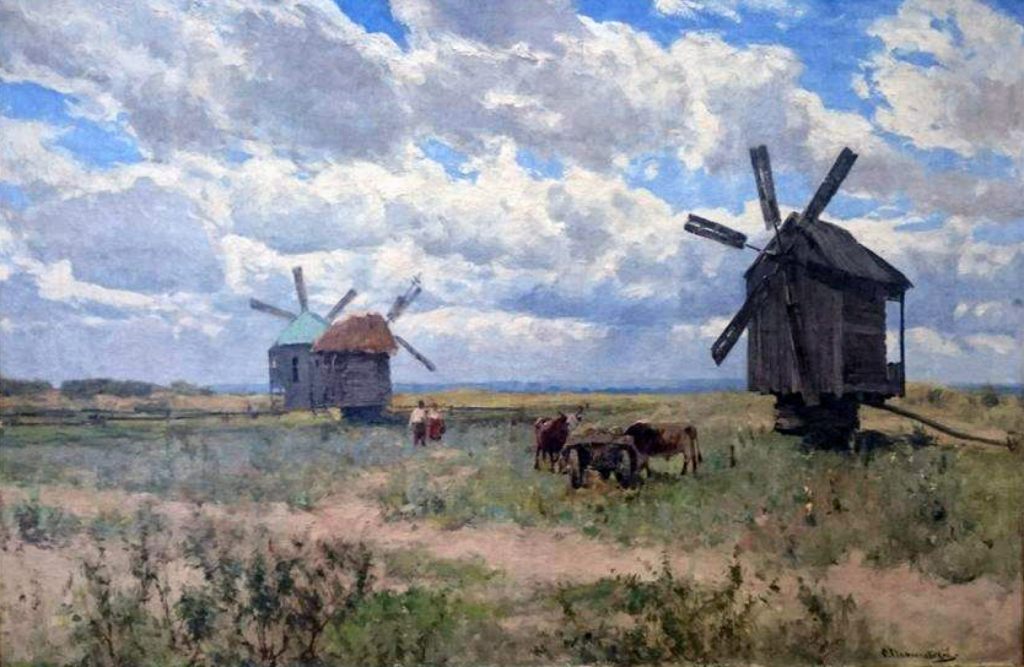Few artists become major sponsors of zoos; this week’s Ukrainian painter, Serhii Svitoslavskyi (1857-1931), was not only instrumental in the founding of Kyiv Zoo in 1909, but the following year went on an expedition to catch animals to swell its collection. He was a prolific landscape painter whose work has fallen out of fashion, and is sadly now largely inaccessible.
Svitoslavskyi was born in Kyiv and went to study at the Moscow School of Painting, Sculpture and Architecture at the age of eighteen. He completed his training there in 1883, and started exhibiting with the Wanderers (Peredvizhniki).

When he was only twenty-one, Svitoslavskyi painted what remains perhaps his best-known work, this view From the Windows of Moscow School of Painting (1878). It’s more closely realist than its Impressionist equivalents, such as Gustave Caillebotte’s Rooftops in the Snow (Snow Effect) from the same year, shown below.

It was through those exhibitions that the affluent Russian collector Pavel Tretyakov bought one of Svitoslavskyi’s paintings in 1879, most probably the view above. A decade later the artist travelled to central Asia, and on his return married and lived in Moscow until 1894.

Svitoslavskyi painted this bleak Winter Landscape somewhere on the steppe during the 1880s.
He returned to Kyiv following his divorce. He set up his studio there and remained until his death in 1931.

He was particularly fond of painting views of the River Dnipro, including this Ferry over the River Dnipro from the early years of the twentieth century.

Landscape with Storks, from the same period, shows a group of white storks returning to their breeding grounds in Ukraine in the early Spring. The huge white stork is the national bird of Ukraine.
In the early twentieth century, Svitoslavskyi’s studio in Kyiv was an important teaching centre, where the artist introduced pupils to plein air techniques and colour tonality. Among those who benefitted from his teaching from 1906 were Oleksandr Bohomazov and Alexander Archipenko, who went on to become significant members of the avant garde.

Ukrainian Landscape with Windmills, probably from about 1911, shows a small cluster of windmills with grazing livestock.
In 1910, Svitoslavskyi’s eyesight started to deteriorate, making his painting progressively more difficult until he was forced to stop.
Kyiv Zoo was founded in 1909 by a local society. Svitoslavskyi seems to have become involved early on, and that year persuaded his patron Pavel Tretyakov to make a large donation to the zoo. Getting animals for its collection proved difficult, so the following year Svitoslavskyi sold his estate and went off with an expedition to central Asia to catch animals to add to the zoo. The collection grew steadily and in 1913 moved to larger permanent premises with heating. It struggled during the First World War, then recovered in the years after the Russian Revolution.
References
Andrey Kurkov and others (2022) Treasures of Ukraine, A Nation’s Cultural Heritage, Thames & Hudson. ISBN 978 0 500 02603 8.
Konstantin Akinsha and others (2022) In the Eye of the Storm, Modernism in Ukraine 1900-1930s, Thames & Hudson. ISBN 978 0 500 29715 5.

